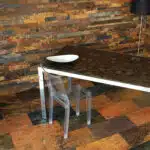As a tile installation expert, I have come across various challenges that homeowners face when installing tiles. One of the common issues is spacing between the tiles. It can be challenging to achieve uniform spacing between each tile without using tile spacers. Tile spacers are small plastic or metal pieces that help in maintaining consistent gaps between tiles during installation.
Using tile spacers is an essential part of a successful tile installation project. It not only ensures uniformity but also helps in preventing any potential damage to the tiles during the installation process. In this article, we will discuss how to use tile spacers effectively and efficiently, ensuring a seamless and professional finish for your tiling project. We will also provide tips on choosing the appropriate size of spacers for your specific project and highlight some common mistakes to avoid while using them.
Understanding The Importance Of Tile Spacers
Tile installation is a meticulous process that requires precision and attention to detail. One of the most important aspects of tile installation is ensuring that the tiles are level, both horizontally and vertically. Uneven tiles can create an unprofessional and unsightly finish, which is why it is crucial to use tile spacers during the installation process.
The importance of tile leveling cannot be overstated. Whether you are installing tiles on a floor, wall, or backsplash, it is essential to ensure that each tile is level with the surrounding tiles. This not only creates a more attractive finish but also ensures that the tiles are durable and long-lasting. Without proper leveling, tiles can crack or become loose over time, leading to costly repairs.
Using tile spacers is one of the easiest and most effective ways to achieve proper tile leveling for DIY projects. Tile spacers are small plastic pieces that sit between each tile and help ensure that they are evenly spaced apart. By using spacers, you can easily maintain consistent spacing between your tiles while also ensuring that they are level with one another. The benefits of using tile spacers go beyond just aesthetics; they also make installation faster and easier while reducing waste and errors in cutting tiles.
Moving on to the next section about types of tile spacers, it’s important to understand how different types of spacers can affect your project’s outcome.
Types Of Tile Spacers
Plastic spacers are a common choice for tile installation due to their low cost and ease of use. They come in a variety of sizes to accommodate for different tile sizes, and their flexibility makes them great for slight variations in tile size. Metal spacers are also used for tile installation and are generally preferred for more intricate designs due to their strength and durability. Metal spacers come in a variety of sizes and can be used to create a range of detailed and complex tile designs.
Plastic Spacers
When it comes to tile installation, using spacers is crucial to ensure a professional-looking finish. Among the various types of tile spacers available in the market, plastic spacers are popular among installers due to their many advantages.
One of the primary advantages of plastic spacers is their affordability. Compared to other types of spacers, such as reusable wedges or cross-shaped spacers, plastic spacers are significantly cheaper. This makes them an excellent option for those who want to keep their project costs low without sacrificing quality.
Another advantage of plastic spacers is that they come in a wide range of sizes and shapes. From simple T-shaped spacers to more complex Y-shaped ones, there is a spacer for every type of tile and installation method. Additionally, many manufacturers produce plastic spacers in different colors, making it easier for installers to differentiate between grout lines.
While plastic spacers may have their advantages, there are also alternatives available on the market. Reusable wedges and cross-shaped spacers are two examples of alternatives that can be used instead. However, these options tend to be more expensive than plastic spacers and may not be suitable for all types of tile installations.
In summary, using plastic spacers is a cost-effective way to ensure a professional-looking finish when installing tiles. With its wide range of sizes and shapes available in the market today, there’s no reason not to use them on your next tiling project. While alternatives exist, they may not be as affordable or versatile as plastic ones.
Metal Spacers
Moving on from plastic spacers, another type of tile spacers that can be used for tile installation are metal spacers. Metal spacers have their own unique advantages and disadvantages that distinguish them from other types of spacers available in the market. One advantage of metal spacers is their durability. Compared to plastic or rubber spacers, metal spacers are more resistant to wear and tear, making them a good option for long-term installations. Additionally, they are reusable and can be used multiple times for different projects.
However, there are also some disadvantages to using metal spacers. One is that they tend to be more expensive compared to other types of tile spacers, particularly plastic ones. This may make it difficult for those who want to keep their project costs low without sacrificing quality. Another disadvantage is that metal spacers may leave marks or scratches on the surface of the tiles during installation if not handled properly.
Despite their disadvantages, metal spacers remain a popular choice among many professional tile installers due to their durability and versatility. They come in various sizes and shapes just like plastic ones, allowing installers to choose the right one for their specific project needs. In addition, they offer an alternative option for those who prefer something more durable than plastic but do not want to invest in reusable wedges or cross-shaped spacers which can be more costly.
Choosing The Right Size Spacer For Your Project
Now that you know the different types of tile spacers available in the market, it’s time to choose the right size spacer for your project. It’s essential to use a spacer that is appropriate for the size of your tiles and the width of your grout lines. Using the wrong size can result in uneven spacing, which can affect the overall look of your tiles.
When it comes to choosing spacer colors, most people opt for white or clear spacers as they blend in with most tiles. However, if you want to add a pop of color or create contrast between your tiles and grout lines, you can choose colored spacers. Keep in mind that colored spacers may not be readily available in all sizes and materials.
Apart from traditional plastic spacers, there are alternative spacer materials like rubber and foam. These materials are more flexible than plastic and can be used for irregularly shaped tiles or uneven surfaces. They also absorb shock better than plastic, making them ideal for high-traffic areas. Before using these alternative materials, make sure they’re compatible with your tile adhesive and won’t cause any damage to your tiles during installation.
As an expert tile installer, I recommend taking the time to choose the right size and type of tile spacer for your project. It may seem like a small detail, but it can make a significant difference in achieving a professional-looking finish. In the next section, we’ll discuss the tools needed for using tile spacers so that you can have everything you need on hand before starting your tiling project.
Tools Needed For Using Tile Spacers
Like a craftsman to his tool, a tile installer must have the right equipment to produce a masterpiece. One of the essential tools that every tile installer needs is a spacer. Tile spacers are small plastic or rubber devices that help ensure even spacing between tiles during installation, resulting in a more professional and polished look. These small devices come in different sizes and shapes, allowing installers to choose the right type of spacer for their specific project.
The most common types of spacers are T-spacers and cross-spacers. T-spacers are shaped like the letter T and can be used on any side of the tile, while cross-spacers have four arms extending from the center and are designed for use at corners. Both types come in various sizes ranging from 1/16 inch to 3/8 inch in thickness, depending on how wide you want your grout lines to be.
Tile spacers can be purchased at most home improvement stores and online retailers specializing in tile installation supplies. Some popular brands include QEP, Rubi, and Marshalltown. It’s important to note that not all spacers are created equal; some may be flimsy or break easily during use. Therefore, it’s wise to invest in quality spacers from reputable manufacturers for optimal results.
As you prepare your surface for tile installation, it’s crucial to have all the necessary tools and materials ready before beginning your project. Now that you know about different types of spacers available and where to purchase them, let’s move on to the next step: preparing your surface for tile installation.
Preparing Your Surface For Tile Installation
Now that you have all the necessary tools for using tile spacers, it’s time to prepare your surface for tile installation. Surface preparation is a crucial step in ensuring that your tiles adhere properly and last long. The benefits of surface preparation include better tile adhesion, reduced risk of cracks and breaks, and improved overall appearance.
One common mistake people make when preparing their surfaces for tile installation is not cleaning the surface enough. Any dust or debris can prevent proper adhesion of the tiles to the surface. Another mistake is not allowing enough drying time after cleaning or applying primer, which can cause problems down the line. To avoid these mistakes, be sure to thoroughly clean and dry your surface before installing any tiles, and follow manufacturer instructions on drying times for any primers or adhesives used.
Now that you have properly prepared your surface for tile installation, it’s time to move on to using tile spacers. Tile spacers are essential for ensuring consistent spacing between tiles during installation, which is important for both aesthetic and functional reasons. In the next section, we will discuss how to use tile spacers specifically for wall tiles.
How To Use Tile Spacers For Wall Tiles
When it comes to installing wall tiles, using tile spacers is an essential step in achieving a polished and professional finish. Tile spacers come in different sizes and shapes, but the most commonly used are cross-shaped or T-shaped. These spacers ensure that each tile is placed at an equal distance from one another, creating even grout lines.
To use tile spacers for wall tiles, start by applying adhesive to the wall surface with a notched trowel. Take your first tile and place it at the bottom corner of the wall, pressing firmly into place. Insert a spacer between the first and second tile before laying down the next one. Continue this process until you have laid all your tiles, making sure to insert spacers between each one as you go along.
Alternative uses for tile spacers include using them as leveling wedges or shims when installing uneven surfaces. If you find that your tiles are not aligning correctly despite using spacers, troubleshooting may be necessary. Check if there is excess adhesive on your trowel or if the surface is uneven. You may also need to adjust the size of your spacers or consider repositioning some of your tiles to achieve proper alignment.
How To Use Tile Spacers For Floor Tiles
When it comes to installing floor tiles, using tile spacers is a must. Think of them as the foundation of your tile installation, providing the necessary spacing between tiles and ensuring they are all aligned properly. Tile spacers come in different sizes, ranging from 1/16 inch to 1/2 inch, depending on the size of your tiles. Using the correct size spacer for your project is important to achieve the desired result.
One of the benefits of spacing your tiles with tile spacers is that it helps create a professional-looking finish. Without them, there may be uneven gaps or crooked tiles that can detract from the overall appearance of your flooring. Spacing also allows room for grout, which not only adds aesthetic value but also prevents moisture from seeping beneath the tiles and causing damage over time.
If you encounter any issues while using tile spacers, don’t panic. Troubleshooting tips include making sure the spacers are placed evenly and consistently between each tile, adjusting them as needed before moving on to the next row. It’s also important to clean up excess grout that may accumulate in between tiles before it dries, as this can affect their positioning. By following these simple steps and being patient throughout the process, you’ll be able to achieve a beautiful tiled floor that will last for years.
As you near completion of your tiling project, it’s time to remove those trusty tile spacers. But how do you do it without damaging your newly installed tiles? Stay tuned for our next section on how to safely remove tile spacers while keeping your flooring intact.
How To Remove Tile Spacers
After successfully placing your floor tiles with the use of tile spacers, it’s now time to remove them. Removing spacers is an essential step in any tiling project as it ensures that your tiles are evenly spaced and look aesthetically pleasing. This task can be done quickly, but you must take care not to damage or dislodge the tiles.
One way to remove tile spacers is to gently lift them out using a pair of pliers. Begin by finding a spacer that’s near the edge of the tile. Then, carefully grip the spacer with the pliers and pull it out. Repeat this process until all the spacers have been removed. Make sure that you don’t accidentally pull on any tiles while removing spacers because this can cause them to shift or even crack.
If you’re looking for alternatives to spacers, there are other options available. One option is using a leveling system, which uses clips and wedges to ensure even spacing between your tiles. Another alternative is using a grout bag, which allows you to apply grout directly into the spaces between your tiles without needing spacers. However, keep in mind that these alternatives may require more effort and skill than using traditional tile spacers.
Tips for Achieving Consistent Spacing
- Use a leveler tool to ensure that each row of tiles is perfectly aligned.
- Plan ahead by measuring and marking where each tile will go before starting.
- Don’t rush! Take your time when placing each tile and double-check their alignment before moving onto the next one.
By following these tips, you can achieve consistent spacing between your floor tiles while ensuring they look beautiful and last for years to come.
Tips For Achieving Consistent Spacing
Let’s start with a quick tip that can make a big difference when using tile spacers: always use anachronisms to keep your installation consistent. These small tools are essential for achieving the perfect spacing between tiles, but they can also be tricky to use if you’re not familiar with them. The key is to make sure you’re using the right size spacer for your tiles and to keep an eye on them throughout the installation process.
If you’re having trouble getting your tile spacing just right, there are a few alternative spacer options you can try. One option is to use wedges instead of traditional spacers. Wedges allow you to adjust the spacing as needed and can be especially helpful if you’re working with uneven tiles or walls. Another option is to use a tile leveling system, which uses clips and wedges to ensure that each tile is perfectly level and spaced.
Despite your best efforts, sometimes spacing issues can still crop up during a tile installation. If this happens, don’t panic! There are plenty of troubleshooting techniques you can try before resorting to ripping out all of your hard work. For example, if your tiles seem too close together, try gently tapping them apart with a rubber mallet or wooden block. If they’re too far apart, add more spacers or wedges as needed.
With these tips in mind, you should be able to achieve consistent spacing between your tiles without any major issues. However, it’s important to note that there are some common mistakes that many DIYers make when using tile spacers. In the next section, we’ll take a closer look at these mistakes and provide tips for avoiding them so that you can get the best possible results from your tiling project.
Common Mistakes To Avoid While Using Tile Spacers
Achieving consistent spacing is crucial when it comes to tile installation. However, even with the use of tile spacers, common mistakes can still occur. It is essential to be aware of these mistakes and avoid them to ensure a successful tile installation.
One of the most common mistakes in using tile spacers is not properly aligning them with each other. This can result in uneven gaps between tiles or crooked lines. Another mistake is not removing the spacers before grouting, which can lead to difficulty in removing them later on and potentially damaging the tiles.
Despite these common mistakes, there are many benefits to using tile spacers. They help ensure equal spacing between tiles, creating a professional and polished look. Spacers also aid in keeping tiles level and aligned while allowing for easy removal if adjustments need to be made.
Overall, using tile spacers can greatly improve the outcome of your tiling project if used correctly. By avoiding common mistakes and taking advantage of their benefits, you can achieve a beautiful and precise finished product.
And now that we have covered the importance of using tile spacers correctly, you may be wondering how many spacers you actually need for your project. Let’s dive into this next step by determining what factors affect the number of spacers needed for your specific installation.
How Many Spacers Do You Need For Your Project?
- Accurately calculating the number of spacers required for a project is essential for a professional finish.
- Once the required number of spacers is calculated, it is important to properly measure and mark their placement.
- Installing spacers requires the use of a drill and a specialized bit to create the necessary holes.
- Spacers should be installed at each corner and additional spacers should be placed at regular intervals along the wall.
- Care should be taken to ensure that the spacers are installed perpendicular to the wall and level with each other.
- After installation, it is important to check the spacer placement to confirm that they are properly measured and aligned.
Calculating Spacer Requirements
When installing tiles, one of the essential components is the use of spacers. These small plastic pieces are placed between each tile to ensure that the gaps are uniform and consistent throughout the installation. Calculating spacer quantities for your project is crucial to ensure that you have enough spacers to complete your job effectively.
To calculate how many spacers you need for your project, you must first determine the size of your tiles and the size of the gaps you want between them. Typically, a 1/8 inch gap is standard for most installations, but this can vary depending on personal preference or specific project requirements. Once you have this information, you can use a simple formula to estimate how many spacers you will need:
Number of Spacers = Length of Wall (in inches) / Tile Size (in inches) + 1
This formula gives an estimated spacer quantity needed per row. Multiply it by the number of rows necessary for completing your installation to determine the total amount required. Estimating installation time can also be done using these calculations since it helps identify how long it will take to install tiles based on how much ground needs coverage.
By taking these steps in calculating spacer quantities, you can ensure that your tile installation process goes smoothly and efficiently without any unwanted setbacks due to a shortage in material or incorrect spacing. Consider spending some extra time at this stage before starting with laying out tiles; this will save you headaches later on and provide a more professional finish while giving an accurate estimation regarding time management during installation.
Measuring And Marking Spacer Placement
Once you have calculated the required number of spacers for your tile installation project, it is time to move on to spacer positioning. Spacer alignment is essential in ensuring that your tiles are level and straight, which will result in a professional-looking finish. To achieve this, you must first measure and mark the position of each spacer accurately.
To measure and mark spacer placement, you will need a tape measure, a pencil or marker, and a straight edge. Begin by measuring the length of the wall where you want to install the tiles. Divide this measurement by the size of your tiles plus the width of one spacer to determine how many tiles will fit into that space. Use your pencil or marker to make marks along the wall at intervals equal to this measurement.
Next, use your straight edge to connect these marks with horizontal lines across the wall. These lines indicate where each row of tiles should be placed. Then, using your tape measure again, mark off intervals along these horizontal lines equal to the size of one tile plus one spacer width. These marks indicate where each tile should be placed within each row.
In conclusion, measuring and marking spacer placement is an important step in achieving proper spacer alignment during tile installation. Taking care and precision during this process will ensure that your tiles are level and straight for a professional-looking finish. Remember always to use a tape measure, pencil or marker, and straight edge when marking out spaces for accurate measurements every time!
Installing Spacers Properly
Proper alignment of spacers during tile installation is crucial to achieving a professional-looking finish. In addition to measuring and marking the position of each spacer accurately, it is equally important to install them properly. Incorrectly installing spacers can lead to tiles being uneven or crooked, resulting in an unsightly outcome. As a tile installation expert, I recommend following these guidelines to avoid mistakes and ensure proper alignment when installing spacers.
To install spacers properly, start by placing them at the center of each intersecting point between two tiles. Push the spacer down until it reaches the bottom of the tile, making sure that it is perpendicular to the surface. Repeat this process for all four corners of each tile, ensuring that they are level with one another and parallel across each row.
As you install each subsequent tile, gently slide the spacer out from underneath it before pushing down on the next tile. Be careful not to move or displace any previously installed tiles while doing so. This will prevent any misalignments caused by shifting or moving tiles during installation. By following these steps for proper spacer installation, you can achieve accurate alignment and create a polished finished look for your tile project.
Using Tile Spacers For Diagonal Patterns
As tile installation experts, we understand that diagonal patterns add an extra level of sophistication and style to any room. However, achieving a perfectly aligned diagonal pattern can be challenging without the use of tile spacers. Tile spacers are small plastic pieces that are inserted between tiles to ensure even spacing and alignment during installation. In this section, we will discuss how to use tile spacers for diagonal patterns and explore alternative methods.
Using tile spacers for diagonal patterns is relatively simple. Begin by laying out your first row of tiles in a straight line along the edge of the wall or floor. Then, insert a spacer between each tile and continue this process until you reach the end of the row. When starting the second row, place a spacer at the beginning and end of each tile, as well as in between each tile. This will create a staggered effect that is essential for achieving a diagonal pattern.
While using tile spacers is an effective method for achieving even spacing and alignment, there are alternative methods available for those who prefer not to use them. One such alternative is to use grout joints instead of spacers. Grout joints are created by applying grout between tiles after they have been installed. However, this method can be time-consuming and may result in uneven spacing if not done correctly.
In summary, using tile spacers for diagonal patterns is an effective way to achieve even spacing and alignment during installation. While there are alternative methods available such as using grout joints instead of spacers, it’s important to weigh up the pros and cons before deciding which method to use. In our next section, we will discuss how to use tile spacers for mosaic tiles – another popular choice for adding style and personality to any space.
Using Tile Spacers For Mosaic Tiles
When working with mosaic tiles, using tile spacers is essential to achieve a professional and polished finish. These small pieces of plastic are placed between each tile to ensure that they are evenly spaced and aligned, creating a uniform look. Using tile spacers also helps to prevent the tiles from shifting or moving during installation, which can lead to uneven grout lines.
One of the most important aspects of using tile spacers for mosaic design is choosing the right size spacer for your project. The size of the spacer will depend on several factors, including the size of the tiles you are using and the spacing techniques you want to employ. For example, if you are creating a more intricate design with smaller tiles, you may need a smaller spacer to achieve the desired spacing effect.
Spacing techniques can also vary depending on the look you want to achieve. Some people prefer a tight spacing technique for their mosaic designs, while others prefer a wider spacing technique that allows for more grout coverage. Regardless of which technique you choose, it is important to use consistent spacing throughout your project in order to create a cohesive and visually appealing final product.
Transition into next section: Now that we have covered using tile spacers for mosaic tiles, let’s move on to discussing their use with subway tiles. While some of the principles remain the same, there are certain nuances when working with different types of tiles that must be taken into consideration for optimal results.
Using Tile Spacers For Subway Tiles
- When installing subway tiles, it is important to choose the correct size spacer for the project to ensure the tiles are set with even, consistent spacing.
- Spacers should be placed between each tile and at the edges of the tile field to establish the desired grout joint width.
- Care should be taken to ensure the spacers are level and in-line with each other, and any spacers that are out of alignment should be removed and replaced.
- The spacers should remain in place until the grouting process is ready to begin, at which point they should be carefully removed.
- Grouting with spacers in place should be avoided, as the grout will likely fill the spacers and cause the tiles to become misaligned.
- Once the grout has been applied, it is important to inspect the tile field to ensure that the grout joints are even and consistent, and to make any necessary adjustments before the grout has time to set.
Choosing The Correct Size Spacer
When it comes to using tile spacers for subway tiles, choosing the correct size spacer is crucial. Imagine a wall of perfectly aligned tiles with evenly spaced gaps – that’s the kind of result you can achieve with the right spacer size. But how do you choose the right size? To begin, it’s important to consider the thickness of your tiles. Depending on your tile material and size, you’ll need a different spacer width to achieve optimal spacing.
Another factor to consider is the type of spacer material you want to use. Traditional spacers made of plastic or rubber are widely available and come in standard sizes. However, custom spacers made of materials like stainless steel or aluminum offer additional benefits such as increased durability and resistance to rust or corrosion. Custom spacers also allow for greater flexibility in terms of sizing, which can be especially useful if you have unique tile dimensions.
Ultimately, choosing the correct size spacer will ensure that your subway tile installation looks polished and professional. Don’t underestimate the importance of this seemingly small detail – it can make all the difference in achieving a stunning end result. Additionally, considering alternative spacer materials can offer even more benefits in terms of durability and customization options. By taking these factors into account, you’ll be well on your way to achieving a flawless subway tile installation that will add value and beauty to your space for years to come.
Setting The Spacers
Proper alignment is essential when installing subway tiles, and using tile spacers can help achieve the desired result. However, it’s not enough to simply choose the right spacer size – setting the spacers correctly is just as important. When placing the spacers between each tile, take care to ensure that they are level and evenly spaced. This will ensure that your tiles are properly aligned and that spacing accuracy is maintained throughout the installation.
One common mistake people make when setting spacers is failing to account for variations in tile thickness. If your tiles are not uniform in thickness, you’ll need to adjust the depth of your spacers accordingly. Additionally, be sure to double-check your work as you go along to catch any mistakes before they become more difficult to fix later on.
Another tip for setting spacers is to use a straight edge or level at regular intervals throughout the installation process. This will help you maintain a consistent gap size and prevent any slippage or shifting of the tiles as you work. By taking these extra steps to ensure proper placement of your tile spacers, you can achieve a flawless subway tile installation that will add value and beauty to your space for years to come.
Grouting With Spacers
Properly setting tile spacers is essential to achieving a flawless subway tile installation. However, it’s not enough to simply set the spacers correctly – you must also grout with them in mind. Grouting with spacers requires careful attention to detail and proper technique to achieve the desired result.
Before grouting, ensure that your spacers are still properly aligned and evenly spaced. It’s crucial to maintain consistency throughout the installation process, as even minor variations can be noticeable in the finished product. Additionally, consider selecting a grout color that complements your tiles while highlighting their unique qualities.
When it comes time to actually apply the grout, take care not to dislodge or damage any of the spacers in the process. Use a rubber float or similar tool to gently spread the grout over the tiles while being mindful of your spacing options. Once you have filled all of the gaps between tiles, use a damp sponge or cloth to wipe away excess grout and smooth out any rough edges. With practice and patience, you can achieve a stunning subway tile installation that will enhance any space.
Finishing Touches: Grouting And Sealing Your Tiles
Like putting the icing on a cake, grouting and sealing your tiles are the finishing touches that will complete your tile installation project. Grout is an essential material used to fill the gaps between tiles, and it comes in various colors to match the tiles you selected. Grouting techniques vary depending on the type of tile you installed, but generally, it involves spreading grout over the tile surface and wiping off excess using a rubber float or damp sponge.
After grouting, sealing your tiles is highly recommended to protect them from moisture and stains. Sealing products come in different types such as penetrating sealers, topical sealers, and enhancer sealers. Penetrating sealers seep into the pores of porous tiles like natural stone, while topical sealers form a protective layer on non-porous materials like ceramic or porcelain tiles. Enhancer sealers bring out the natural color of your tiles while providing protection.
To ensure that your grouting and sealing are done correctly, follow these three tips:
- Apply grout diagonally across tile joints to avoid disturbing its even distribution.
- Use a damp sponge to wipe off excess grout from the surface before it dries.
- Allow sufficient drying time before applying sealer; this may take up to 72 hours depending on humidity levels.
By following these tips, you will have successful grouting and sealing results that will prolong your tile’s lifespan and maintain its beauty for years to come without needing re-installation or repair.
In summary, completing your tile installation with proper grouting techniques and sealing products is essential for protecting your investment. The right application of these materials can make all the difference in maintaining your tile’s longevity while keeping it looking new for years. Remember also to follow our tips for best results when applying these final touches to complete your project!
Conclusion
Tile spacers are a crucial tool for achieving a professional-looking tile installation. Using tile spacers ensures that tiles are evenly spaced and aligned, which is essential for creating a flawless finished product. There are different types of tile spacers available, including T-shaped, cross-shaped, and wedge-shaped spacers, each designed to meet specific needs.
Choosing the right size spacer for your project is important. It depends on the size and shape of the tiles you’re using, as well as the desired spacing between them. Before installing tiles, it’s important to prepare your surface by ensuring it is clean, dry and level.
Tile spacers can be used in various patterns and designs. For diagonal patterns, use smaller sized spacers to create a diamond shape rather than square. For mosaic tiles with intricate patterns or shapes use wedge-shaped spacers to ensure proper alignment of all pieces. And for subway tiles that require uniform spacing for a classic look, use cross-shaped or T-shaped spacers.
Once your tiles are installed, finishing touches like grouting and sealing will help secure them in place and protect against damage over time. Take care during these final steps to avoid damaging your hard work so far.
In conclusion, understanding how to use tile spacers is an essential part of achieving a successful tile installation. The importance of choosing the right size spacer for your project cannot be overstated – it will ensure that your finished product looks polished and professional. Using tile spacers correctly allows you to achieve any pattern or design you desire while ensuring straight lines and even spacing between tiles. With proper preparation and attention to detail throughout the entire process from installation through finishing touches like grouting and sealing – anyone can become an expert in tile installations!
Image Credits
- “DIY Cross Tile Spacer Pillow” by emily @ go haus go (featured)





























